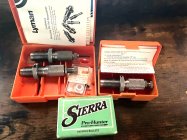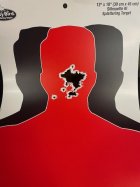Thanks to a member here, I just got a new (to me) set of Lyman 303 British reloading dies, including a neck expander die, a shell holder, and a bonus box of Sierra 303 British bullets.
I already had a set of Lee 303 British dies, but that set is more-or-less dedicated to a portable range reloading kit that I'll post at some point for interested viewers to see what I take to the range for on-site range reloading.
This happens to be my first LYMAN reloading die set. I have most of the rest of the "popular" die manufacturers sets on my bench, including RCBS, Lee, Hornady, Redding and Dillon.
As I told the seller, these dies will not become bench ornaments. They are going to get a lot of use. 303 British happens to be the only "Bottleneck" cartridge that I reload. The rest are straight wall cartridges used in lever action rifles, like 357 Mag, 44 Mag and 45 Long Colt.
So this weekend will be a 303 Reloading Festival on my bench.

I already had a set of Lee 303 British dies, but that set is more-or-less dedicated to a portable range reloading kit that I'll post at some point for interested viewers to see what I take to the range for on-site range reloading.
This happens to be my first LYMAN reloading die set. I have most of the rest of the "popular" die manufacturers sets on my bench, including RCBS, Lee, Hornady, Redding and Dillon.
As I told the seller, these dies will not become bench ornaments. They are going to get a lot of use. 303 British happens to be the only "Bottleneck" cartridge that I reload. The rest are straight wall cartridges used in lever action rifles, like 357 Mag, 44 Mag and 45 Long Colt.
So this weekend will be a 303 Reloading Festival on my bench.














